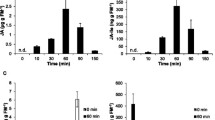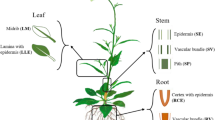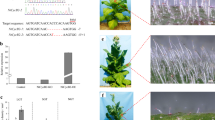Abstract
Key Message
Methyl jasmonate treatment and aphid resistance assays reveal different roles in herbivore defensive responses between tobacco glandular and non-glandular trichomes. These roles correlate with trichome gene expression patterns.
Abstract
In plants, trichomes greatly contribute to biotic stress resistance. To better understand the different defensive functions between glandular and non-glandular trichomes, we used Nicotiana tabacum as a model. This species bears three types of trichomes: long and short stalk glandular trichomes (LGT and SGT, respectively), and non-glandular trichomes (NGT). Tobacco accession T.I.1068 (lacking NGT) and T.I.1112 (lacking LGT) were used for the experiment. After methyl jasmonate (MeJA) treatment, LGT formation was promoted not only in T.I.1068, but also in T.I.1112, whereas NGT remained absent in T.I.1068, and was slightly reduced in T.I.1112. Diterpenoids, which play important roles in herbivore resistance, accumulated abundantly in T.I.1068 and were elevated by MeJA; however, they were not found in T.I.1112 but became detectable after MeJA treatment. The aphid resistance of T.I.1068 was higher than that of T.I.1112, and both were enhanced by MeJA, which was closely correlated with LGT density. Trichomes detached from T.I.1068 and T.I.1112 were used for RNA-Seq analysis, the results showed that pentose phosphate, photosynthesis, and diterpenoid biosynthesis genes were much more expressed in T.I.1068 than in T.I.1112, which was consistent with the vigorous diterpenoid biosynthesis in T.I.1068. In T.I.1112, citrate cycle, propanoate, and glyoxylate metabolism processes were enriched, and some defensive protein genes were expressed at higher levels than those in T.I.1068.These results suggested that LGT plays a predominant role in aphid resistance, whereas NGT could strengthen herbivore resistance by accumulating defensive proteins, and the roles of LGT and NGT are associated with their gene expression patterns.






Similar content being viewed by others
Availability of data and materials
All data generated or analyzed during this study are included in this published article (and its supplementary information files). The raw filtered RNA-seq data used in this article are available in the NCBI Sequence Read Archive (SRA) (https://www.ncbi.nlm.nih.gov/sra/) under BioProject accession: PRJNA577245.
Abbreviations
- DEG:
-
Differentially Expressed Gene
- ESEM:
-
Environmental Scanning Electron Microscopy
- GC–MS:
-
Gas Chromatography-Mass Spectrometry
- HPLC–MS/MS:
-
High-performance liquid chromatography-tandem mass spectrometry
- LGT:
-
Long stalk Glandular Trichome
- MeJA:
-
Methyl Jasmonate
- MEP:
-
2-C-methyl-D-erythritol 4-phosphate pathway
- MVA:
-
Mevalonate pathway
- NGT:
-
Non-Glandular Trichome
- PCA:
-
Principal component analysis
- SGT:
-
Short stalk Glandular Trichome
References
Alain T (2018) Harnessing plant trichome biochemistry for the production of useful compounds. In: Kermode AR, Jiang L (eds) Molecular pharming: applications, challenges and emerging areas. Wiley Blackwell, New York, pp 353–382
Anders S, Huber W (2012) Differential expression of RNA-Seq data at the gene level–the DESeq package. European Molecular Biology Laboratory. https://www.genomatix.de/online_help/help_regionminer/DESeq_1.10.1.pdf.2012. Accessed 12 Sept
Anders S, Pyl PT, Huber W (2014) HTSeq - a Python framework to work with high-throughput sequencing data. Bioinformatics 31:166–169
Arigoni D, Sagner S, Latzel C, Eisenreich W, Bacher A, Zenk MH (1997) Terpenoid biosynthesis from 1-deoxy-D-xylulose in higher plants by intramolecular skeletal rearrangement. Proc Natl Acad Sci USA 94:10600–10605
Boughton AJ, Hoover K, Felton GW (2005) Methyl jasmonate application induces increased densities of glandular trichomes on tomato, Lycopersicon esculentum. J Chem Ecol 31:2211–2216
Burk LG, Chaplin JF, Jackson DM (1982) Inheritance of the glandless leaf trichome trait in Nicotiana tabacum L. Tob Sci 26:51–53
Cardoso MZ (2008) Herbivore handling of a plant’s trichome: The case of Heliconius charithonia (L.) (Lepidoptera : Nymphalidae) and Passiflora Lobata (Killip) Hutch. (Passifloraceae). Neotrop Entomol 37:247–252
Cui H, Zhang S-T, Yang H-J, Ji H, Wang X-J (2011) Gene expression profile analysis of tobacco leaf trichomes. BMC Plant Biol 11:76
Dai X, Wang G, Yang DS, Tang Y, Broun P, Marks MD, Sumner LW, Dixon RA, Zhao PX (2010) TrichOME: a comparative omics database for plant trichomes. Plant Physiol 152:44–54
Dalin P, Ågren J, Björkman C, Huttunen P, Kärkkäinen K (2008) Leaf trichome formation and plant resistance to herbivory. In: Schaller A (ed) Induced plant resistance to herbivory. Springer Netherlands, Dordrecht, pp 89–105
Disch A, Hemmerlin A, Bach TJ, Rohmer M (1998) Mevalonate-derived isopentenyl diphosphate is the biosynthetic precursor of ubiquinone prenyl side chain in tobacco BY-2 cells. Biochem J 331:615–621
Doroshkov AV, Konstantinov DK, Afonnikov DA, Gunbin KV (2019) The evolution of gene regulatory networks controlling Arabidopsis thaliana L. trichome development. BMC Plant Biol 19:53
Edwards KD, Fernandez-Pozo N, Drake-Stowe K, Humphry M, Evans AD, Bombarely A, Allen F, Hurst R, White B, Kernodle SP, Bromley JR, Sanchez-Tamburrino JP, Lewis RS, Mueller LA (2017) A reference genome for Nicotiana tabacum enables map-based cloning of homeologous loci implicated in nitrogen utilization efficiency. BMC Genomics 18:448
Ennajdaoui H, Vachon G, Giacalone C, Besse I, Sallaud C, Herzog M, Tissier A (2010) Trichome specific expression of the tobacco (Nicotiana sylvestris) cembratrien-ol synthase genes is controlled by both activating and repressing cis-regions. Plant Mol Biol 73:673–685
Frerigmann H, Böttcher C, Baatout D, Gigolashvili T (2012) Glucosinolates are produced in trichomes of Arabidopsis thaliana. Front Plant Sci 3:242
Glas J, Schimmel B, Alba J, Escobar-Bravo R, Schuurink R, Kant M (2012) Plant glandular trichomes as targets for breeding or engineering of resistance to herbivores. Int J Mol Sci 13:17077–17103
Gurr GM, McGrath D (2002) Foliar pubescence and resistance to potato moth, Phthorimaea operculella, in Lycopersicon hirsutum. Entomol Exp Appl 103:35–41
Hare JD, Walling LL (2006) Constitutive and jasmonate-inducible traits of Datura wrightii. J Chem Ecol 32:29–47
Huang M, Zhang H, Wang Z, Niu D, Li Y, Cui H (2018) Comparative studies of leaf surface chemical biosynthesis in different tobacco cultivars. Acta Physiol Plant 40:67
Huchelmann A, Boutry M, Hachez C (2017) Plant glandular trichomes: natural cell factories of high biotechnological interest. Plant Physiol 175:6–22
Kandra L, Wagner GJ (1988) Studies of the site and mode of biosynthesis of tobacco trichome exudate components. Arch Biochem Biophys 265:425–432
Karabourniotis G, Kofidis G, Fasseas C, Liakoura V, Drossopoulos I (1998) Polyphenol deposition in leaf hairs of Olea Europaea (OLeaceae) and QUercus Ilex (Fagaceae). Am J Bot 85:1007–1012
Khederi SJ, Khanjani M, Hosseini MA, Leite GLD, Jafari M (2014) Role of different trichome style in the resistance of Lycopersicon hirsutum genotypes to Tuta absoluta (Meyrick)(Lepidoptera: Gelechiidae). Ecologica Montenegrina 1:55–63
Kim D, Langmead B, Salzberg SL (2015) HISAT: a fast spliced aligner with low memory requirements. Nat Methods 12:357–360
Kobayashi H, Yanaka M, Ikeda TM (2010) Exogenous methyl jasmonate alters trichome density on leaf surfaces of rhodes grass (Chloris gayana Kunth). J Plant Growth Regul 29:506–511
Koudounas K, Manioudaki M, Kourti A, Banilas G, Hatzopoulos P (2015) Transcriptional profiling unravels potential metabolic activities of the olive leaf non-glandular trichome. Front Plant Sci 6:633
Kupke T, Hernandez-Acosta P, Culianez-Macia FA (2003) 4’-phosphopantetheine and coenzyme A biosynthesis in plants. J Biol Chem 278:38229–38237
Li C, Wang P, Menzies NW, Lombi E, Kopittke PM (2018) Effects of methyl jasmonate on plant growth and leaf properties. J Plant Nutr Soil Sci 181:409–418
Lin Y, Wagner GJ (1994) Rapid and simple method for estimation of sugar esters. J Agric Food Chem 42:1709–1712
Maes L, Goossens A (2010) Hormone-mediated promotion of trichome initiation in plants is conserved but utilizes species and trichome-specific regulatory mechanisms. Plant Signal Behav 5:205–207
Maes L, Van Nieuwerburgh FCW, Zhang Y, Reed DW, Pollier J, Vande Casteele SRF, Inzé D, Covello PS, Deforce DLD, Goossens A (2011) Dissection of the phytohormonal regulation of trichome formation and biosynthesis of the antimalarial compound artemisinin in Artemisia annua plants. New Phytol 189:176–189
McDowell ET, Kapteyn J, Schmidt A, Li C, Kang JH, Descour A, Shi F, Larson M, Schilmiller A, An L, Jones AD, Pichersky E, Soderlund CA, Gang DR (2011) Comparative functional genomic analysis of Solanum glandular trichome types. Plant Physiol 155:524–539
Miret JA, Munné-Bosch S (2014) Plant amino acid-derived vitamins: biosynthesis and function. Amino Acids 46:809–824
Plaxton WC (1996) The organization and regulation of plant glycolysis. Annu Rev Plant Physiol Mol Biol 47:185–214
Pottier M, Laterre R, Van Wessem A, Ramirez AM, Herman X, Boutry M, Hachez C (2020) Identification of two new trichome-specific promoters of Nicotiana tabacum. Planta 251:58
Qi T, Song S, Ren Q, Wu D, Huang H, Chen Y, Fan M, Peng W, Ren C, Xie D (2011) The jasmonate-ZIM-domain proteins interact with the WD-Repeat/bHLH/MYB complexes to regulate jasmonate-mediated anthocyanin accumulation and trichome initiation in Arabidopsis thaliana. Plant Cell 23:1795–1814
Rakha M, Bouba N, Ramasamy S, Regnard J-L, Hanson P (2017a) Evaluation of wild tomato accessions (Solanum spp.) for resistance to two-spotted spider mite (Tetranychus urticae Koch) based on trichome type and acylsugar content. Genet Resour Crop Ev 64:1011–1022
Rakha M, Hanson P, Ramasamy S (2017b) Identification of resistance to Bemisia tabaci Genn. in closely related wild relatives of cultivated tomato based on trichome type analysis and choice and no-choice assays. Genet Resour Crop Ev 64:247–260
Roberts K, Thurston R, Jones G (1981) Density of types of trichomes on leaf lamina of various tobacco cultivars. Tob Sci 25:68–69
Sallaud C, Giacalone C, Topfer R, Goepfert S, Bakaher N, Rosti S, Tissier A (2012) Characterization of two genes for the biosynthesis of the labdane diterpene Z-abienol in tobacco (Nicotiana tabacum) glandular trichomes. Plant J 72:1–17
Sallets A, Beyaert M, Boutry M, Champagne A (2014) Comparative proteomics of short and tall glandular trichomes of Nicotiana tabacum reveals differential metabolic activities. J Proteome Res 13:3386–3396
Schwender J, Zeidler J, Gröner R, Müller C, Focke M, Braun S, Lichtenthaler FW, Lichtenthaler HK (1997) Incorporation of 1-deoxy-d-xylulose into isoprene and phytol by higher plants and algae. Febs Lett 414:129–134
Serna L, Martin C (2006) Trichomes: different regulatory networks lead to convergent structures. Trends Plant Sci 11:274–280
Shen Q, Lu X, Yan T, Fu X, Lv Z, Zhang F, Pan Q, Wang G, Sun X, Tang K (2016) The jasmonate-responsive AaMYC2 transcription factor positively regulates artemisinin biosynthesis in Artemisia annua. New Phytol 210:1269–1281
Shepherd RW, Bass WT, Houtz RL, Wagner GJ (2005) Phylloplanins of tobacco are defensive proteins deployed on aerial surfaces by short glandular trichomes. Plant Cell 17:1851–1861
Simmons AT, Gurr GM, McGrath D, Nicol HI, Martin PM (2003) Trichomes of Lycopersicon spp. and their effect on Myzus persicae (Sulzer) (Hemiptera: Aphididae). Aust J Entomol 42:373–378
Slocombe SP, Schauvinhold I, McQuinn RP, Besser K, Welsby NA, Harper A, Aziz N, Li Y, Larson TR, Giovannoni J, Dixon RA, Broun P (2008) Transcriptomic and reverse genetic analysesof branched-chain fatty acid and acyl sugar production in Solanum pennellii and Nicotiana benthamiana. Plant Physiol 148:1830–1846
Soetaert SS, Van Neste CM, Vandewoestyne ML, Head SR, Goossens A, Van Nieuwerburgh FC, Deforce DL (2013) Differential transcriptome analysis of glandular and filamentous trichomes in Artemisia annua. BMC Plant Biol 13:220
Tan H, Xiao L, Gao S, Li Q, Chen J, Xiao Y, Ji Q, Chen R, Chen W, Zhang L (2015) TRICHOME AND ARTEMISININ REGULATOR 1 is required for trichome development and artemisinin biosynthesis in Artemisia annua. Mol Plant 8:1396–1411
Thimm O, Bläsing O, Gibon Y, Nagel A, Meyer S, Krüger P, Selbig J, Müller LA, Rhee SY, Stitt M (2004) MAPMAN: a user-driven tool to display genomics data sets onto diagrams of metabolic pathways and other biological processes. Plant J 37:914–939
Tian D, Tooker J, Peiffer M, Chung SH, Felton GW (2012) Role of trichomes in defense against herbivores: comparison of herbivore response to woolly and hairless trichome mutants in tomato (Solanum lycopersicum). Planta 236:1053–1066
Tooker J, Peiffer M, Luthe DS, Felton GW (2010) Trichomes as sensors. Plant Signal Behav 5:73–75
Trapnell C, Roberts A, Goff L, Pertea G, Kim D, Kelley DR, Pimentel H, Salzberg SL, Rinn JL, Pachter L (2012) Differential gene and transcript expression analysis of RNA-seq experiments with TopHat and Cufflinks. Nat Protoc 7:562–578
Traw MB, Bergelson J (2003) Interactive effects of jasmonic acid, salicylic acid, and gibberellin on induction of trichomes in Arabidopsis. Plant Physiol 133:1367–1375
Van Cutsem E, Simonart G, Degand H, Faber AM, Morsomme P, Boutry M (2011) Gel-based and gel-free proteomic analysis of Nicotiana tabacum trichomes identifies proteins involved in secondary metabolism and in the (a)biotic stress response. Proteomics 11:440–454
van Schie CCN, Haring MA, Schuurink RC (2007) Tomato linalool synthase is induced in trichomes by jasmonic acid. Plant Mol Biol 64:251–263
Vom Endt D, Kijne JW, Memelink J (2002) Transcription factors controlling plant secondary metabolism: what regulates the regulators? Phytochemistry 61:107–114
Wagner GJ (1991) Secreting glandular trichomes: more than just hairs. Plant Physiol 96:675–679
Wamelink MMC, Struys EA, Jakobs C (2008) The biochemistry, metabolism and inherited defects of the pentose phosphate pathway: a review. J Inherit Metab Dis 31:703–717
Wang E, Wagner GJ (2003) Elucidation of the functions of genes central to diterpene metabolism in tobacco trichomes using posttranscriptional gene silencing. Planta 216:686–691
Wang E, Wang R, DeParasis J, Loughrin JH, Gan S, Wagner GJ (2001) Suppression of a P450 hydroxylase gene in plant trichome glands enhances natural-product-based aphid resistance. Nat Biotechnol 19:371–374
Wang E, Gan S, Wagner GJ (2002) Isolation and characterization of the CYP71D16 trichome-specific promoter from Nicotiana tabacum L. J Exp Bot 53:1891–1897
Wang W, Wang Y, Zhang Q, Qi Y, Guo D (2009) Global characterization of Artemisia annua glandular trichome transcriptome using 454 pyrosequencing. BMC Genomics 10:465
Werker E (2000) Trichome diversity and development. Adv Bot Res 31:1–35
Wickham H (2011) ggplot2. Wires Comput Stat 3:180–185
Xie C, Mao X, Huang J, Ding Y, Wu J, Dong S, Kong L, Gao G, Li CY, Wei L (2011) KOBAS 2.0: a web server for annotation and identification of enriched pathways and diseases. Nucleic Acids Res 39:W316-322
Xu J, van Herwijnen ZO, Dräger DB, Sui C, Haring MA, Schuurink RC (2018) SlMYC1 regulates type VI glandular trichome formation and terpene biosynthesis in tomato glandular cells. Plant Cell 30:2988–3005
Yan T, Chen M, Shen Q, Li L, Fu X, Pan Q, Tang Y, Shi P, Lv Z, Jiang W, Ma Y-n, Hao X, Sun X, Tang K (2017) HOMEODOMAIN PROTEIN 1 is required for jasmonate-mediated glandular trichome initiation in Artemisia annua. New Phytol 213:1145–1155
Yoshida Y, Sano R, Wada T, Takabayashi J, Okada K (2009) Jasmonic acid control of GLABRA3 links inducible defense and trichome patterning in Arabidopsis. Development 136:1039–1048
Zhang H, Ma X, Li W, Niu D, Wang Z, Yan X, Yang X, Yang Y, Cui H (2019) Genome-wide characterization of NtHD-ZIP IV: different roles in abiotic stress response and glandular trichome induction. BMC Plant Biol 19:444
Funding
This research was funded by the Natural Science Foundation of Henan province [Grant No. 182300410094], the State Tobacco Monopoly Administration of China [Grant No. 110202101005 (JY-05)], and China Tobacco Henan Industrial Co., Ltd. [Grant No. AW202149].
Author information
Authors and Affiliations
Contributions
HC and ZW designed the research. ZW, YL and HZ performed the aphid resistance analysis. XY observed the trichomes. ZW analyzed the RNA-Seq data. ZW and HC wrote the paper. All authors read and approved the final manuscript.
Corresponding author
Ethics declarations
Conflict of interest
The authors declare that they have no competing interests.
Additional information
Communicated by Da-Bing Zhang.
Publisher's Note
Springer Nature remains neutral with regard to jurisdictional claims in published maps and institutional affiliations.
Supplementary Information
Below is the link to the electronic supplementary material.

299_2021_2801_MOESM1_ESM.jpg
Supplementary Fig. S1 Environmental scanning electron microscope (ESEM) micrographs of trichomes collected from (A) T.I.1068 and (B) T.I.1112 (JPG 1720 KB)

299_2021_2801_MOESM2_ESM.jpg
Supplementary Fig. S2 Environmental scanning electron microscope (ESEM) micrographs of leaf trichomes on T.I.1068 and T.I.1112. (A) Trichomes in T.I.1068. (B) Zoomed view of long stalk glandular trichomes (LGT) in T.I.1068. (C) Trichomes in T.I.1112. (D) Zoomed view of short stalk glandular trichomes (SGT) and non-glandular trichomes (NGT) in T.I.1112 (JPG 1081 KB)
299_2021_2801_MOESM3_ESM.tif
Supplementary Fig. S3 Heat map of gene expression difference in jasmonic acid (JA) biosynthesis pathways between T.I.1068 and T.I.1112 (A) and endogenous jasmonic acid (JA) content of T.I.1068 and T.I.1112 (B). The genes expressed higher in T.I.1068 are shown in red with a color scale to indicate log2-fold changes. 13-LOX, 13-lipoxygenase; AOS, allene oxide synthase; AOC, allene oxide cyclase; OPR3, ( +)-12-oxo-phytodienoic acid reductase 3; OPCL1, 3-oxo-2-( 2-pentenyl)-cyclopentane-1-octanoyl-CoA ligase 1; ACX, acyl-CoA oxidase; MFP, multifunctional protein with 2-trans-enoyl-CoA hydratase and L-3-hydroxyacyl-CoA dehydrogenase activity; KAT, 3-ketoacyl-CoA thiolase (TIF 1829 KB)
299_2021_2801_MOESM6_ESM.xlsx
Supplementary Table S3 The list of differentially expressed genes (DEGs) more expressed in T.I.1068 than in T.I.1112 (XLSX 489 KB)
299_2021_2801_MOESM7_ESM.xlsx
Supplementary Table S4 The list of differentially expressed genes (DEGs) more expressed in T.I.1112 than in T.I.1068 (XLSX 465 KB)
299_2021_2801_MOESM8_ESM.xls
Supplementary Table S5 The list of all KEGG pathways of the differentially expressed genes (DEGs) more expressed in T.I.1068 than in T.I.1112 (XLS 70 KB)
299_2021_2801_MOESM9_ESM.xls
Supplementary Table S6 The list of all KEGG pathways of the differentially expressed genes (DEGs) more expressed in T.I.1112 than in T.I.1068 (XLS 78 KB)
Rights and permissions
About this article
Cite this article
Wang, Z., Li, Y., Zhang, H. et al. Methyl jasmonate treatment, aphid resistance assay, and transcriptomic analysis revealed different herbivore defensive roles between tobacco glandular and non-glandular trichomes. Plant Cell Rep 41, 195–208 (2022). https://doi.org/10.1007/s00299-021-02801-6
Received:
Accepted:
Published:
Issue Date:
DOI: https://doi.org/10.1007/s00299-021-02801-6




